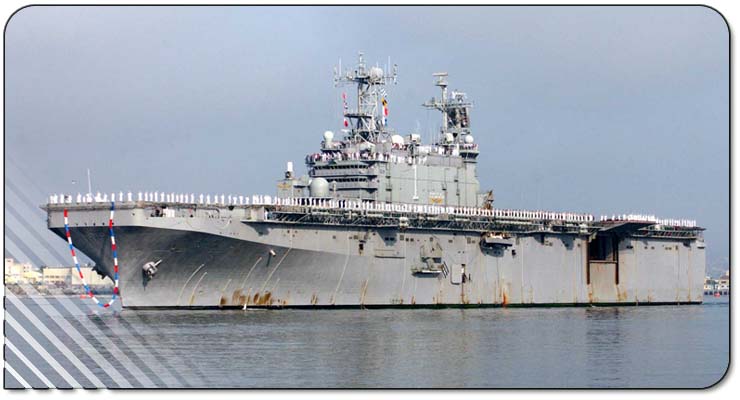Namesake:
Battle of Tarawa
The Central Pacific's Gilbert Islands were strategically important to
the Allies in World War II. Tarawa, and atoll in those islands, was the
scene of a major amphibious assault and on of the proudest testaments
to valor in U.S. Marine Corps history.
Japan's Rear Admiral Shibasaki Meichi was quoted as saying before the
assault that it would take the American forces "a million men and a
hundred years" to capture the atoll. The Japanese had backed up this
boast with an elite force of almost 5,000 men and heavily fortified the
island of Betio in the southwestern corner of the atoll. Since
capturing the islands three days after the attack on Pearl Harbor, the
Japanese had spent two years positioning coastal defense guns,
antiaircraft guns, anti-boat guns, light and heavy machine guns, and an
airstrip they could use to strike at allied troops stationed in the
area. The atoll was strategically vital to both sides, and the stage
was set for one of the bloodiest battles in the Pacific.
The Allies were faced with serious problems in capturing Tarawa. The
big coastal guns would keep the Navy guns either under constant fire or
at bay, and the Japanese had used sunken ships and other pieces of
metal to create obstacles which blocked the avenues of approach from
the sea. The approaching craft would have to slow down to maneuver,
putting them in prearranged ambush sites where they would be subject to
deadly, concentrated fire from fortified positions. The next line of
obstacles included a double apron of barbed wire, log barriers, and
concrete obstacles which surrounded the island. After breaching these
defenses, the Marines would still be faced with the beach itself, where
the Japanese had fortified heavy machine guns which created a series of
interlocking fields of fire in addition to antipersonnel mines and
anti-vehicle mines in the fringing reefs where the boats would have to
land. With the added benefit of antiaircraft guns and planes of their
own, the defenders were well prepared for any assault.
The Allies had to take Tarawa, however, and on November 19, 1943 the
assault began. Faced with the near-impossible odds and hounded from all
sides, the Marines made it to the beach; by the last day of battle the
Japanese had been forced into the east end of the the three-mile long
island. They had prepared a series of fortified positions to fall back
on in their retreat, and had defended each one almost to the last man.
Those three miles may be some of the longest in Marine Corps history,
as they slowly advanced at a terrible price. Organized resistance on
Tarawa ceased by 1:30 PM on the third day.
The Battle of Tarawa took 76 hours and cost the lives of 1,020 Marines.
The list of Americans wounded was listed as high as 2,296. The cost was
much higher for the Japanese defenders- of the 4,386 elite troops on
Betio, only 146 were left alive.
Four Marines received the Medal of Honor for their heroism, three of
them posthumously. The fourth, Colonel David M. Shoup, Commanding
Officer of the 2nd Marines and Betio Island Assault forces, later
became the Commandant of the Marine Corps.
|

